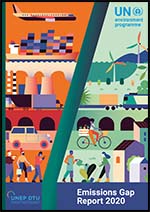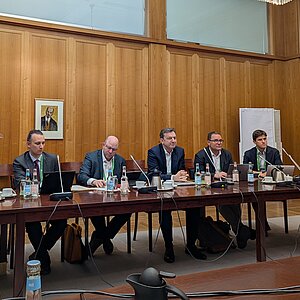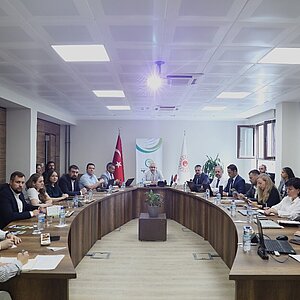IKI funding area: Mitigating greenhouse gas emissions
Setting the course for global climate neutrality by 2050 with a focus on energy, industry and mobility (last updated: May 2024)

The Paris Agreement calls for global warming to be limited to well below 2 degrees Celsius, and preferably below 1.5 degrees Celsius, in order to minimise the consequences of climate change. Achieving this goal will require a fundamental restructuring of the economy and society, including complete decarbonisation by the middle of the century.
IKI’s approaches to reducing greenhouse gases from 2024
The overarching objectives of the International Climate Initiative (IKI) are to finance the socio-ecological transformation, support international negotiation processes and promote the sustainable and climate-friendly development of urban areas.
In order to achieve the Sustainable Development Goals (SDGs) of the 2030 Agenda, it is important that we also consider the multitude of interactions between measures to reduce greenhouse gases and adapt to climate change as well as other development goals.
Among other things, the International Climate Initiative (IKI) supports its partner countries in developing and implementing innovative instruments to reduce their greenhouse gas emissions as well as the necessary framework to do so. The goal is a transformation towards a sustainable and greenhouse gas-neutral economic and supply structure.
The four priority fields of action in the mitigation funding area
The Strategy of the International Climate Initiative up to 2030 defines four priority fields of action in the area of mitigation:
1. Raising ambitions
At the political management level, the IKI supports its partner countries in the ambitious further development and implementation of Nationally Determined Contributions (NDCs) and Long-Term Strategies (LTS).
2. Energy transition
In order to achieve a global energy transition, the IKI promotes the expansion of renewable energies, improvement of energy efficiency, the expansion of energy storage systems, grid expansion and sector coupling, meaning the use of renewable energies for heating, cooling or drives.
3. Decarbonisation of industry
In the decarbonisation of industry field of action, the IKI sees considerable potential for greenhouse gas mitigation, particularly in its priority countries. Instruments here include setting standards and accounting frameworks, policy development, Carbon Border Adjustment Mechanisms (CBAM), green procurement and CO2 pricing instruments for industry.
[Read more about Carbon market - Greenhouse gas emissions trading ...]
4. Mobility transition
Aiming to foster low carbon mobility transition on a global scale, IKI’s focus is on energy transition in the transport sector (for example by replacing internal combustion with electric engines), alongside measures to avoid traffic and to increase a modal shift towards collective transport options. Starting points include robust MRV systems for the transport sector, integration into NDCs and the development of ambitious regulations. Direct implementation takes place through local pilot measures.
Further key points for the project work
The mobilisation of private capital plays a particularly important role in the mitigation funding area and should be taken into account in a large number of projects. The land use sector (for example through agriculture) and the financial sector are also relevant to mitigation.
Other actions that contribute to achieving climate targets include the development of a climate- and resource-friendly recycling and waste management system as well as the establishment of sustainable production and consumption methods.
The IKI also provides support for the development of monitoring, reporting and verification (MRV) systems in its partner countries and – in line with the Paris Agreement – systems to ensure the transparency of greenhouse gas emissions, the implementation of specific mitigation activities and the reorganisation of financial institutions.
The IKI expressly welcomes the dovetailing of mitigation activities with measures to adapt to climate change and/or to protect biodiversity.
In terms of methodology, the mitigation funding area focuses on policy advice, capacity building, technology cooperation, project preparation and the mobilisation of private capital.
At a glance
From 2008 until the end of 2023, some 624 projects with a total volume of around 2.8 billion euros were approved in the “Mitigating greenhouse gas emissions” funding area.
Selected projects
- Cool Up: Upscaling Sustainable Cooling
- Clean, affordable and secure energy for Southeast Asia (CASE)
- Clean captive installations for industrial clients in Sub-Sahara Africa
- Growing smarter – sustainable mobility in East Africa
- Supporting low-emission energy industries to achieve climate targets in the Dominican Republic
- EcoLogistics: Low carbon freight for sustainable cities
- BUILD ME – boosting ambitions to achieve a climate-neutral building standard in the MENA region
Briefly explained: CBAM
To ensure fair competitive conditions between European producers that are part of the European CO₂ certificate trading scheme and importers from third countries, a Carbon Border Adjustment Mechanism (CBAM) is to be set up. As a result, in future, a price will also be imposed on CO₂ emissions of certain energy-intensive products that are imported into the EU.
About the IKI
Cross-cutting topics of the IKI
Supporting international negotiation processes
Funding the socio-ecological transformation

Developing sustainable urban and peri-urban areas

Publications
-
 02/ 2024 | Educational material
02/ 2024 | Educational materialPodcast „[insert solutions here]. Climate meets Democracy"
English (external link)
-

-

-

The link has been copied to the clipboard



















![[Translate to English:]](/fileadmin/_processed_/a/4/csm_20250327_PhomPenh_AdobeStock_1290631159_bf56228de3.jpg)




